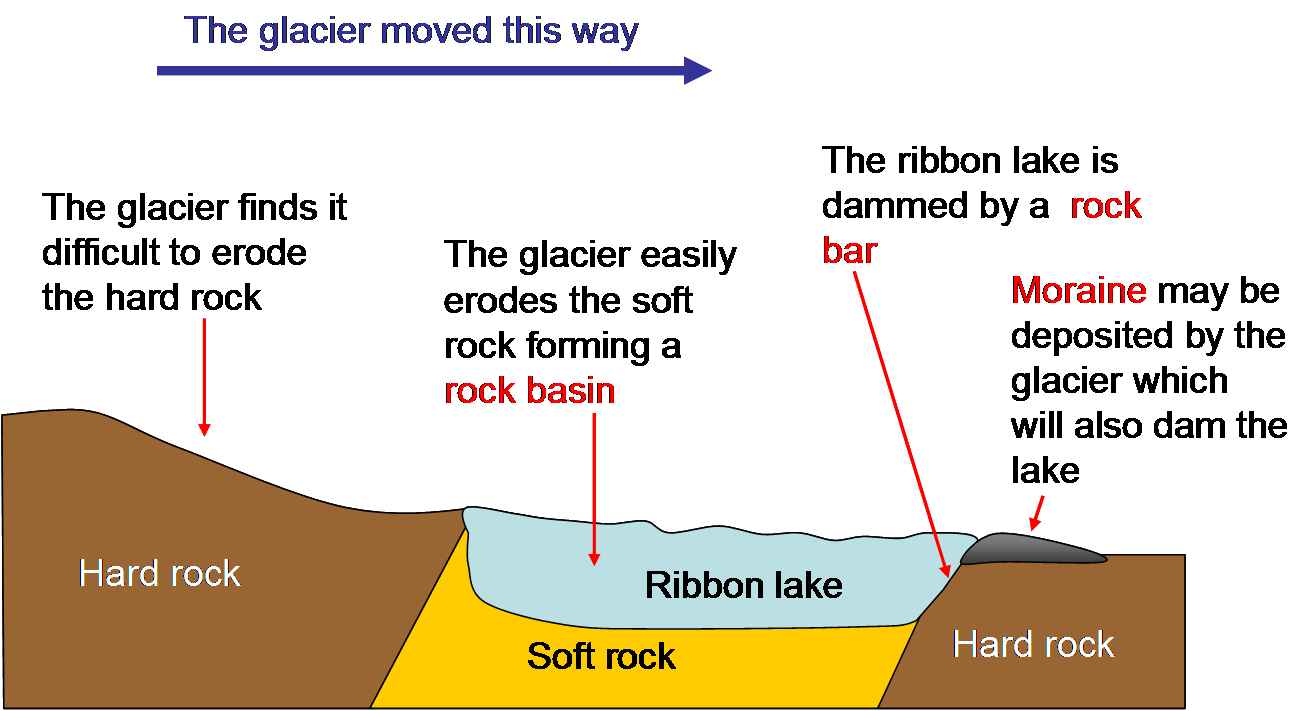Ribbon lake on:
[Wikipedia]
[Google]
[Amazon]

 A ribbon lake is a long and deep, finger-shaped
A ribbon lake is a long and deep, finger-shaped
Online at Google Books
Glacial erosion landforms Lakes by type {{geo-term-stub

 A ribbon lake is a long and deep, finger-shaped
A ribbon lake is a long and deep, finger-shaped lake
A lake is an area filled with water, localized in a basin, surrounded by land, and distinct from any river or other outlet that serves to feed or drain the lake. Lakes lie on land and are not part of the ocean, although, like the much large ...
, usually found in a glacial trough. As such, a ribbon lake is one of a number of glacial landscapes, including arête
An arête ( ) is a narrow ridge of rock which separates two valleys. It is typically formed when two glaciers erode parallel U-shaped valleys. Arêtes can also form when two glacial cirques erode headwards towards one another, although frequ ...
s, corries, rock lips, rock basins and terminal moraines.
Such a lake's formation begins when a glacier
A glacier (; ) is a persistent body of dense ice that is constantly moving under its own weight. A glacier forms where the accumulation of snow exceeds its ablation over many years, often centuries. It acquires distinguishing features, such as ...
moves over an area containing alternate bands of hard and soft bedrock. The sharp-edged boulders that are picked up by the glacier and carried at the bottom of the glacier erode the softer rock more quickly by abrasion, thus creating a hollow called a rock basin. On either side of the rock basin, the more resistant rock is eroded less and these outcrops of harder rock are known as rock bars, which act as dams between which rainwater may accumulate after the retreat of the ice age
An ice age is a long period of reduction in the temperature of Earth's surface and atmosphere, resulting in the presence or expansion of continental and polar ice sheets and alpine glaciers. Earth's climate alternates between ice ages and gre ...
, filling up the rock basin and creating a ribbon lake. A ribbon lake may also form behind a terminal or recessional moraine, both of which also act as dams, enabling water to accumulate behind them.
A ribbon lake may also occur if a tributary glacier joins a main glacier. The increase in power can create a trough, which is filled with water from a river/meltwater to create a ribbon lake.
Examples of ribbon lakes include Windermere
Windermere (sometimes tautologically called Windermere Lake to distinguish it from the nearby town of Windermere) is the largest natural lake in England. More than 11 miles (18 km) in length, and almost 1 mile (1.5 km) at its wides ...
, the largest natural lake in England
England is a country that is part of the United Kingdom. It shares land borders with Wales to its west and Scotland to its north. The Irish Sea lies northwest and the Celtic Sea to the southwest. It is separated from continental Europe b ...
; Panguipulli Lake
The Panguipulli Lake ( ; es, Lago Panguipulli) is one of the " Seven Lakes" in Panguipulli municipality, southern Chile. The lake is of glacial origin and it is enclosed by mountain ranges of the Andes, on all sides except the west, where the to ...
, in southern Chile
Chile, officially the Republic of Chile, is a country in the western part of South America. It is the southernmost country in the world, and the closest to Antarctica, occupying a long and narrow strip of land between the Andes to the east a ...
; Lake Washington, in the state of Washington
Washington commonly refers to:
* Washington (state), United States
* Washington, D.C., the capital of the United States
** A metonym for the federal government of the United States
** Washington metropolitan area, the metropolitan area centered o ...
; and Llyn Ogwen, in northwestern Wales
Wales ( cy, Cymru ) is a country that is part of the United Kingdom. It is bordered by England to the east, the Irish Sea to the north and west, the Celtic Sea to the south west and the Bristol Channel to the south. It had a population in ...
.
References
Online at Google Books
Glacial erosion landforms Lakes by type {{geo-term-stub